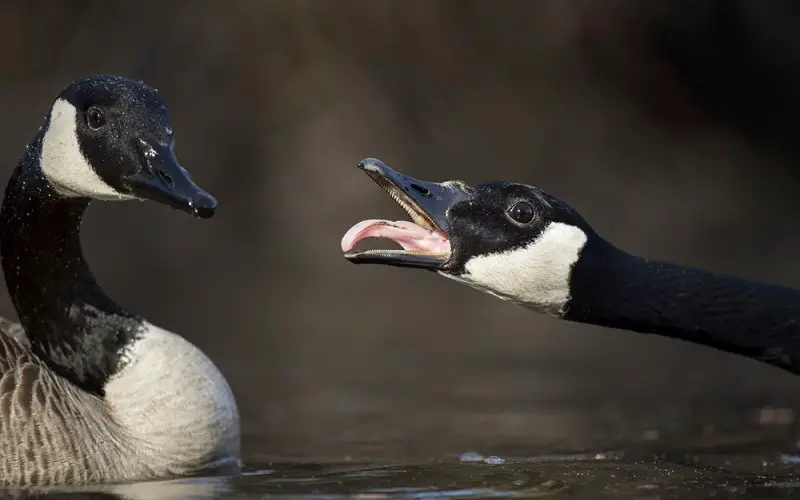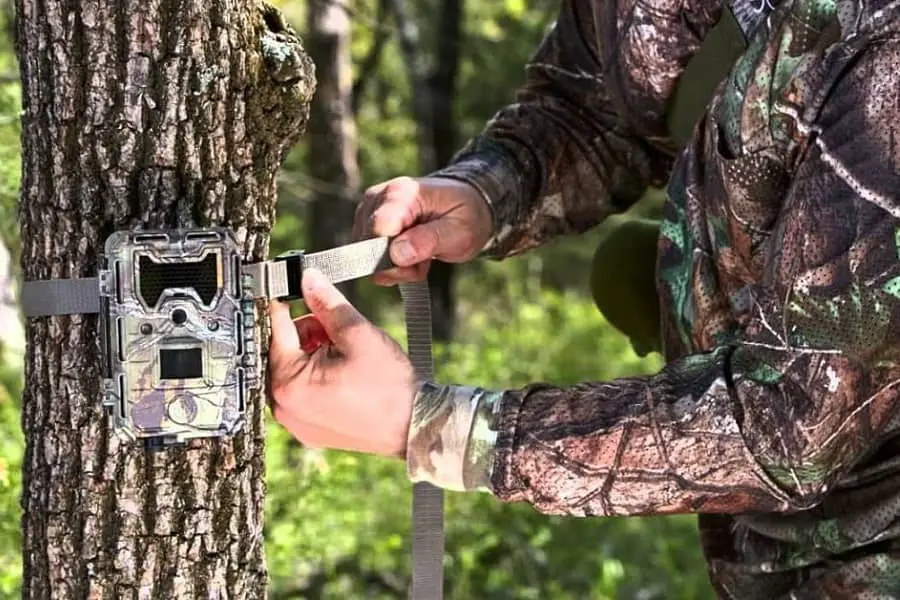With that in mind, let’s now take a closer look at our top picks.
While one of the definitions of hunting is “searching”, the most successful hunters are often the ones who can make their prey come to them.
And that is twice as true when it comes to waterfowl hunting, which is why a good call can make the difference between bagging your limit and coming home empty-handed.
A Goose Call is a device designed to bring geese to your location by making sounds that mimic the call of a goose.
Some of the best goose calls are blown into like a whistle, while others are electronic and only require pushing a button.
Planning To Hunt Geese? You Can’t Do It Without This Goose Call!
FAULK’S CANADA GOOSE CALL
- Keeps perfect tone
- Great traveling sound
- Faulk's canada goose call
Why is it better than the rest?
- Includes lanyard with your purchase
- Wood construction ensures tone retention throughout the use
- Extra-large barrel helps sound travel farther
Five Best Goose Calls





Let’s dive into the specifics and review each goose call individually. You can use the list below to jump and review specific models, or you can read along and go through all the information.
Faulk’s Canada Goose Call
- Keeps perfect tone
- Great traveling sound
- Faulk's canada goose call
In Canada, goose hunting is actually pretty common.
Much like how we have Duck Dynasty, they have Faulk’s, which provides some of the most accurate honkers on the market.
Made entirely out of zebrawood, this call retains the perfect tone no matter how often you use it.
That’s good because this thing rattles.
When you blow into the narrow end, the extra-large barrel releases a whopper of a noise, traveling far and reaching the ears of geese (and ducks & mallards, for that matter) everywhere.
With your purchase, Faulk’s includes a lanyard to keep this around your neck at all times.
It’s got a bit of stretch to it, so it won’t just be dangling off your chest and tapping against your gun the whole time.
They say some of the most simple things in life are the best. This displays one type of call, does it well, and works wonders when you’re out in the middle of the woods.
It is also very durable thanks to the good build. Some acrylic calls are brittle and eventually break, but not this one.
FEATURES
- Includes lanyard with your purchase
- Wood construction ensures tone retention throughout use
- Extra-large barrel helps sound travel farther
Primos Hunting 866 Goose Call
- Easy-to-blow, short Reed Goose call
- Patented ditches will not allow the call to stick
- Patented Reed system lets you disassemble the call for cleaning and...
You never want to get a goose or duck call that’s going to take the wind out of you. Instead, you could opt for a brand like Primos to take the hassle out of it.
Personally, it’s one of the easiest calls I’ve had to use. It’s got me wondering if a strong wind would make it sound off!
The low growl hits the perfect tone for geese, and what I like most about this is that it doesn’t lose that tone at any point during use.
A cheap call will start to fizzle out to a slightly different sound and might spook the geese.
This reed system allows you to just pull it apart for cleaning without needing much force.
Cleaning is pretty simple as a result, just be careful that you don’t drop the small reed pieces.
FEATURES
- The patented reed system makes this super simple to clean and maintain
- Easy to blow; doesn’t require lots of force
- Produces a low growl call perfect for mating season
Zink Power Clucker PC-1 Polycarbonate Goose Call
- ULTIMATE PERFORMANCE - Creating waterfowl calls from Zink requires...
- GREAT HUNTING GOOSE CALL - The Zink PC-1 Polycarb Hunting Game Call is...
- SUPER-REALISTIC SOUNDS - The PC-1 Polycarb Canada Goose Call uses a...
I’m a big fan of the saying “You get what you pay for,” and sometimes I am admittedly a bit skeptical of a product based on its price. Zink proved me otherwise.
Built out of a high-durability polycarbonate, they’re able to keep the cost of this call very low, while still making it top-of-the-line in terms of quality.
Since this type of call is usually lower in pitch than duck calls, less force is required when blowing into them.
With Zink, you barely have to push out more than a simple breath to get the sound of the call going.
Unlike solid color pieces, you can see where this call needs to be cleaned. It uses a very short reed system, but one that works well.
The mouthpiece, while also being made of polycarbonate, feels smooth and makes using your call an overall enjoyable experience.
FEATURES
- A durable mouthpiece that cleans extremely easily
- Emits sound with little to no effort
- Low-cost, high-quality call
Buck Gardner Double Nasty 2 Canada Hammer
- Easy operation
- Fast, responsive reed pick-up
- Quick-Tune guts system
Most calls end up being fairly low in terms of sound output, but Buck Gardner wanted to give you a bit more versatility.
Depending on the season, a cluck might do better to lure in the geese.
Depending on how hard you blow, you’ll either get a hail or a soft clucking sound to really reel them in.
This is all thanks to their large reed system, visible through the polycarbonate mouthpiece.
That mouthpiece is contoured, so you’re not dealing with a standard O-ring style piece.
This makes it far easier to blow into the mouthpiece and maximize wind to the reed.
In short, it sends the call from a quiet hum to a loud hail in almost no time.
The less breath you have to waste, the more you can hold when you’re locking in your shots. That’s how I look at it.
FEATURES
- Hand shaved reed makes for a high-quality design
- Breath intensity dictates low clucks or loud hails
- Extremely affordable price point
Flambeau Outdoors BR189 Long Honker Goose Flute
- EASY-TO-USE: The traditional Long Honker flute design is revered as...
- IRRESISTIBLE NATURAL SOUND: The Long Honker specializes in voluminous...
- MOSSY OAK CAMO FINISH: The Flambeau Outdoors Long Honker Goose Flute...
The one issue with the products we’ve already looked at is that they don’t blend in. They’re clear, or red, but nobody makes them with a camo pattern like Flambeau.
This keeps you invisible during the hunt. While the pattern is great, the proof is in the pudding.
The sealed O-ring prevents air leaking from any point in the tubular design, while also creating a minimal air pressure requirement.
It’s a simple call that’s built tough, with high versatility, and designed to last for every waterfowl hunting trip you have planned. Plain and simple, just how it should be.
FEATURES
- Creates a low, grunt-like call; perfect for mating season
- No air leakage thanks to enhanced O-ring
- Woodland camo design helps you blend in
How To Identify The Best Goose Calls?
WHO INVENTED THE Goose CALL?

Back in 1870, a man named Elam Fisher (ironic last name) created the first goose call by making a combo of a short reed and a mouthpiece together.
But before then, in 1863, the first modern duck call was developed, which acts as a predecessor to the short reed goose call.
Nowadays there are many manufacturers of high-quality calls.
Among some of the better-known (notable mentions aside from the ones included above) are Eastern Shoreman, Haydel, Sean Mann Outdoors, Tim Grounds, Rich-N-Tone, and Primos Hunting.
HOW DOES A GOOSE CALL WORK?
The calls require a few working parts. One of those is the barrel length, which dictates the tone of the sound coming out.
You also have your reed, which is primarily where the sound escapes from. Once you blow in through the input, also known as the insert, then your air goes in through the gut assembly.
Barrel, insert, assembly—that’s all you need to make the sound. However, you also need an O-ring to seal off the barrel to ensure that no air is going to leak out during use.
The insert and barrel also need to be designed in a way to require minimal air input with maximum effect.
The shape and size of the barrel can define the pressure of air being blown in, which enacts the reed to make the call sound.
There’s a lot that goes into getting the right tone to lure waterfowl to your decoy, but the basic construction of a goose call is simple enough.
HOW DO YOU CLUCK A GOOSE CALL?

Clucking calls is something that many people struggle with. Clucking is a variation of a duck moan, which can be achieved with a few very simple tips to keep in mind.
Even if you have a reed that’s tough to get air through, do not blow too hard. The first mistake people make is assuming that a cluck has to be loud. It’s not supposed to be.
By keeping your tongue at the bottom of your mouth, you’re going to provide some light back pressure from your throat.
You’re going for vocal cord vibrations, not so much a huff of air leaving all at once. Since clucking usually lasts 10-15 seconds, you don’t want to run out of breath before you’re done.
Tongue on the bottom, lightly blow air from your mouth like it’s vibrating your inner cheeks. Remember, the target is to give a slight back pressure—not a full-blown trucker-honk one.
Blow in, and snap your tongue up to the roof of your mouth. You’re going to hear a slight moan.
From there, drop your tongue so that sound drops off. This means it will naturally sort of taper off and sound authentic to your prey. From there, just repeat that step for 10-15 seconds.
Vibrate the vocal cords, pop the tongue up and drop it down after every second, and soon you won’t be able to tell the difference between your call and a real goose. It sounds that authentic.
Keep in mind that you can create many different sounds with these calls. After some practice, you’ll start to approach the field-proven calls that experienced goose hunters take for granted.
You could do this, or use an old-fashioned flute call. There aren’t many of these in practice anymore since they’re limiting.
In my opinion, using a standard call and learning how to manipulate the goose sounds to release a cluck is far more advantageous.
Try imitating, for example, a speckle belly or a Canadian goose-style call.
HOW MANY GOOSE CALLS DO YOU NEED?
It depends on where you hunt. There are over one-hundred breeds of geese, all of which are fairly easily distinguishable, and then there are subspecies.
Those are mostly just found in North America as well, so you could run into several different breeds wherever you go.
Different breeds of geese have various ways that they can be called over. Some prefer a lower sound, while others like a cluck with a light flutter to lure them in.
Some calls will straight up send some geese away. Believe it or not, geese are vicious creatures and they’re very territorial.
If they think another breed of geese is approaching (one that’s tougher than they are), they might leave the area in a flock, so it’s very important to get your calls right.
References:






